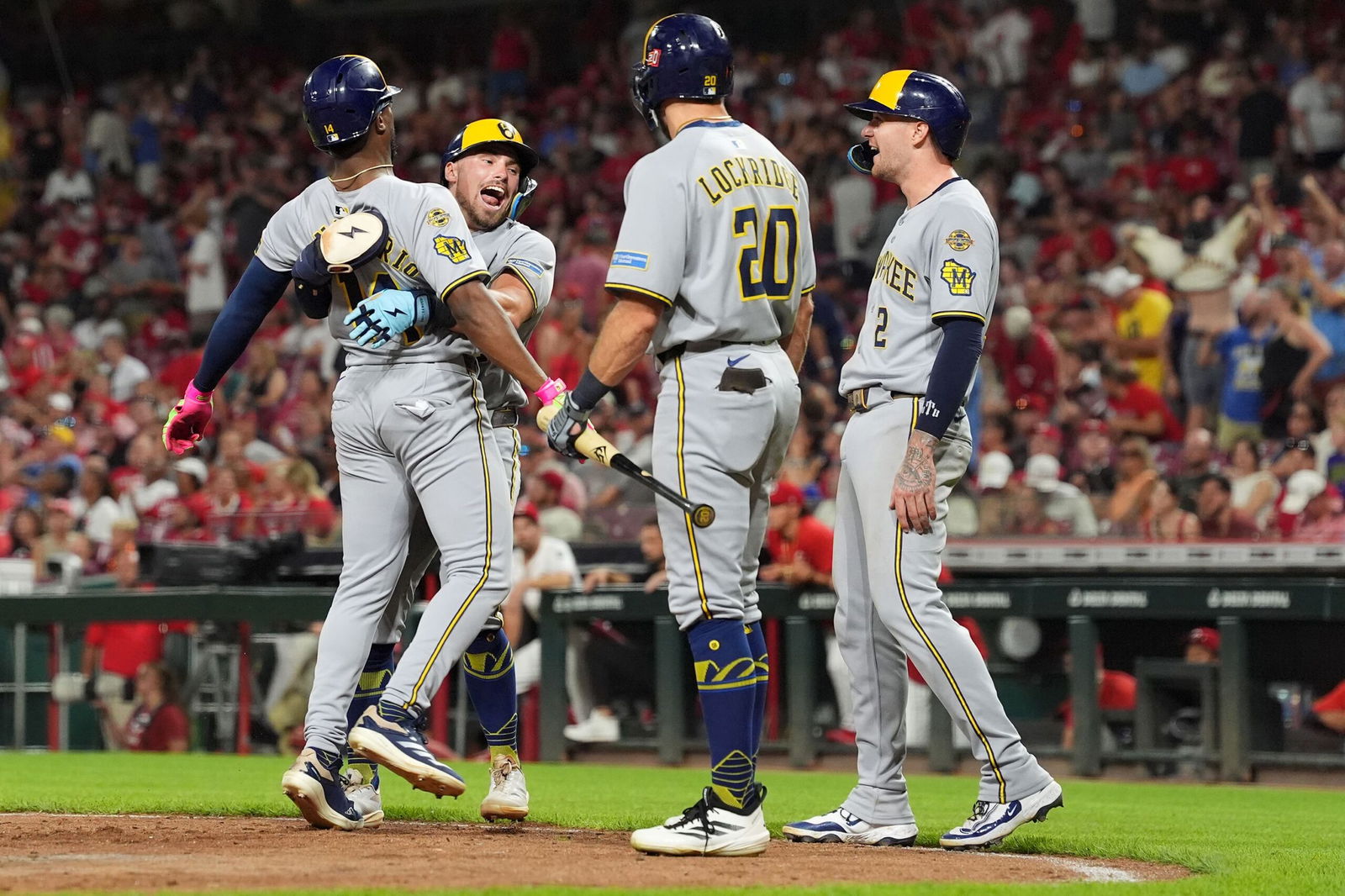MLB’s hottest team has no big stars and a third of the Los Angeles Dodgers’ budget. What is their secret?

Milwaukee Brewers third baseman Caleb Durbin hits a double in the seventh inning against the Cincinnati Reds on August 16.
By Issy Ronald, CNN
(CNN) — Among the usual top baseball teams this season, there is another, more unexpected name.
The Milwaukee Brewers have some exciting young players but no real stars and their payroll is the tenth lowest of the 30 Major League Baseball teams, about one third of what the Los Angeles Dodgers pay.
Yet they are the hottest team in MLB right now, frequently at the top of the power rankings and riding a franchise record streak of 14 consecutive wins, sealed by a 6-5 victory against the Cincinnati Reds in 11 innings on Saturday. Not since the Seattle Mariners in 2022 has any MLB team enjoyed such a long winning run.
And somewhat befitting this team, eight of those are comeback wins, a rarity among teams who have recorded 14 wins in a row.
They are now at 78-44 with a nine-game lead over the Chicago Cubs in the NL Central and are eight games better than the Dodgers and the Philadelphia Phillies, the National League’s next best teams.
Such success isn’t entirely new to the Brewers – they have made the postseason in six of the past seven seasons – but their recent record-breaking exploits and rise to become the hottest team in baseball have focused the national spotlight on the ragtag team from Milwaukee.
So, if they don’t have big stars or a big checkbook, how exactly are they putting such a run together?
‘Everyone is contributing’
Such a streak represents a remarkable turnaround from the start of the season when the Brewers were swept by the New York Yankees and projected to be an under .500 team.
Still, while much of its pitching staff has returned from injury since March and April, the Brewers have not been able to rely on one big hitter.
Even after they lost Jackson Chourio, one of their best young sluggers this season, to injury when they played the Washington Nationals earlier this month, all nine starting players got a hit, the league-leading eighth time that’s happened this season.
“Everyone is contributing every single night,” rookie Isaac Collins said. “It’s a new guy every night … one through nine we’re just getting the job done, getting through one pitch at a time. And whoever is called upon is delivering for us.”
While the headlines are often dominated by big sluggers, the Brewers excel in other areas. They run hard; defend hard; prevent runs; and are the second best team in MLB at stealing bases.
Manager Pat Murphy simply attributes his team’s success to a group of “average Joes playing hard.”
“I don’t think that’s a secret formula. It certainly isn’t me. It’s just that this is the group we’re with. We’re not gonna spend a lot of money, we didn’t sign anybody in the offseason. We didn’t spend money. We dropped money.
“That’s just who we are. Let’s be authentic about it. We’re not gonna go sign the free agents. If we play this way, maybe we got a shot, maybe we don’t.”
Smart trading
While Murphy may seek to downplay his role, it is his personality and approach to recruiting which seeps through the Brewers’ organization.
A former college baseball head coach at Arizona State, Murphy always sought to recruit “orange Life Savers,” as he once described it in an interview with the Milwaukee Journal Sentinel, referencing the popular candy.
“What’s the first thing you do when you get a pack of Life Savers?” Murphy said. “You open it up and you take the red ones. Everyone likes the red ones. Nobody wants the orange. I always had a theory that I liked the orange Life Savers.”
Unlike many other smaller-market teams, the Brewers aren’t built on drafting and developing players – they only have seven homegrown players on their current 26-man roster.
Instead, 13 players from their roster have been acquired in trades, the third highest tally in the league behind only the Tampa Bay Rays and Seattle Mariners, following Murphy’s “orange Life Savers” theory.
They’ve made a habit of spotting potential unrealized elsewhere, whether that is in someone like Andrew Vaughn – the No. 3 pick in the 2019 Draft who had failed to make much of an impression at the Chicago White Sox – pitcher Quinn Priester who had a 6.46 ERA at points early in his career or even Isaac Collins, who was a ninth-round pick for the Colorado Rockies in 2019 before playing in the minor leagues for the Brewers.
All of them have become integral for the Brewers. Collins’ on-base percentage is the 11th highest in the league and he might well be named NL Rookie of the Year, at the age of 28. Priester has a 3.48 ERA now while Vaughn has become an important part of the Brewers’ lineup.
Power of youth
Many of the players the Brewers have acquired through trades are still young, still hungry to prove themselves.
They have the joint fifth-youngest batting order in the MLB this season, after offloading veterans like Devin Williams and Willy Adames during the offseason.
Chourio, their 21-year-old budding superstar, became the youngest player ever to have a 20-20 season last year. He has continued that form this season, batting .276 with 17 home runs and a 20-game hitting streak between July 2-27.
Meanwhile, rookie pitcher Jacob Misiorowski, who wields a fastball which reaches speeds as high as 103 mph (166 kph) has announced himself as an impressive talent too. Though he struggled on his return from injury on Friday, he had a 2.70 ERA with 47 strikeouts and 14 walks in his seven starts before getting injured.
With the likes of Misiorowksi and Chourio proving themselves and Murphy at the helm, the Brewers are looking capable of making a deep run into the postseason.
The-CNN-Wire
™ & © 2025 Cable News Network, Inc., a Warner Bros. Discovery Company. All rights reserved.
CNN’s Jamie Barton contributed reporting.


